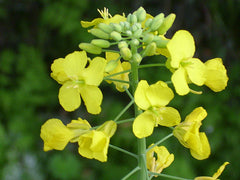Genista tinctoria, Dyer's Greenweed
A very good quality yellow dye is obtained from the whole plant, but especially from the flowers and young shoots.
A good bee plant.
It produces a very good quality green when mixed with woad (Isatis tinctoria). Alum, cream of tartar and sulphate of lime are used to fix the colour. The stems can be dried and stored until the dye is required.
Plants can be used as a ground cover when spaced about 45cm apart each way.
A fibre obtained from the stems is used for coarse cloth and cordage.
Easily grown in a light well-drained soil in a sunny position. Prefers a rather dry soil, tolerating poor and sandy soils. Prefers a lime-free soil. Succeeds in acid or basic soils.
A very cold-tolerant plant, tolerating temperatures down to about -35°c. Resents root disturbance and should only be transplanted whilst young. Sometimes cultivated as a dye plant, it is usually treated as a biennial for this purpose, the whole plant being harvested in the second year. Plants do not require pruning, but they can be cut back as required once they have finished flowering in order to maintain shape.
A good bee plant.
The seed requires a period of cold stratification and is best sown autumn in a cold frame. Pre-soak stored seed for 24 hours in warm water and sow February in a cold frame.
Easily grown in a light well-drained soil in a sunny position. Prefers a rather dry soil, tolerating poor and sandy soils. Prefers a lime-free soil. Succeeds in acid or basic soils.
A very cold-tolerant plant, tolerating temperatures down to about -35°c. Resents root disturbance and should only be transplanted whilst young. Sometimes cultivated as a dye plant, it is usually treated as a biennial for this purpose, the whole plant being harvested in the second year. Plants do not require pruning, but they can be cut back as required once they have finished flowering in order to maintain shape.
This species has a symbiotic relationship with certain soil bacteria, these bacteria form nodules on the roots and fix atmospheric nitrogen. Some of this nitrogen is utilized by the growing plant but some can also be used by other plants growing nearby.
Edible uses:
The seed has been suggested as a possible coffee substitute.
The flower buds are pickled and used as a substitute for capers.
Used as a vegetable.



![Photo By H. Zell (Own work) [GFDL (http://www.gnu.org/copyleft/fdl.html) or CC-BY-SA-3.0 (http://creativecommons.org/licenses/by-sa/3.0)], via Wikimedia Commons](http://www.openpollinated.co.uk/cdn/shop/products/1_386be0ac-24e2-488b-9e5f-b303145d8af9_thumb.jpeg?v=1510586916)






